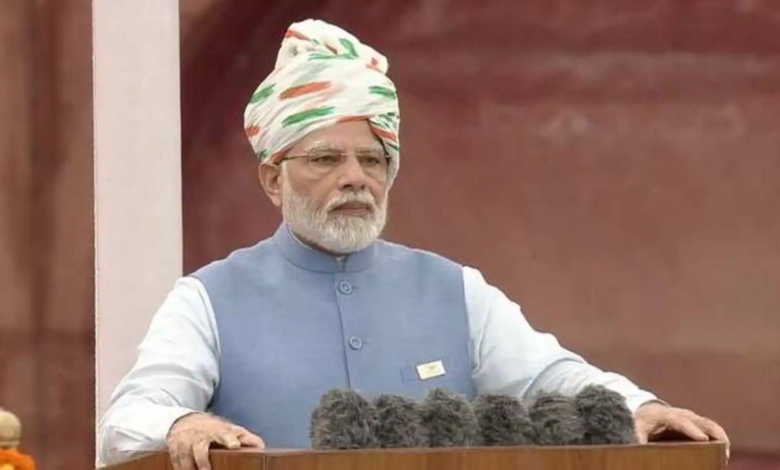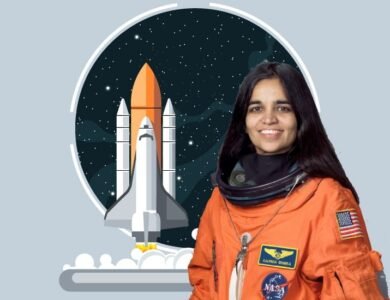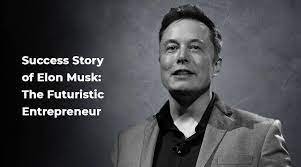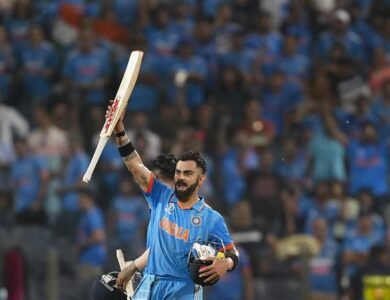Unraveling Modi: The Journey of India’s 14th Prime Minister
Charting India's Destiny: The Modi Story

Unraveling Modi: The Journey of India’s 14th Prime Minister
In the vibrant tapestry of India’s political history, one name stands out like a bright thread of determination and change. Narendra Modi, the 14th Prime Minister of the world’s largest democracy, is a man of humble beginnings who has etched his indomitable presence on the canvas of Indian politics. From a modest upbringing in a small town to the grandeur of the Prime Minister’s office, his journey is a remarkable narrative of ambition, resilience, and leadership. This is the story of Narendra Modi, a man who started as a tea seller and went on to become one of the most influential figures in Indian and global politics.
Early Life and Background of Narendra Modi:
Narendra Modi’s early life and background played a significant role in shaping his character and political journey. Born on September 17, 1950, in Vadnagar, a small town in the state of Gujarat, India, he was the third of six children in a modest family.
- Humble Beginnings:
Modi was born into a family of grocers. His father, Damodardas Modi, ran a small tea stall at the Vadnagar Railway Station, and his mother, Heeraben Modi, worked as a domestic helper to support the family. The family’s financial circumstances were far from affluent, and young Narendra Modi experienced the challenges of a modest upbringing.
- Early Education:
Modi attended the local school in Vadnagar and showed an early aptitude for learning. He was an enthusiastic and inquisitive student who displayed an early interest in debates and public speaking. His teachers and classmates recall his intelligence and disciplined nature.
- Spiritual Pursuits:
Even in his youth, Modi displayed an inclination toward spiritual and philosophical pursuits. He often visited a nearby ashram, where he engaged in discussions on philosophy and meditation. These experiences would later influence his approach to life and politics.
- Marriage and Family:
At a young age, Narendra Modi was married to Jashodaben, an arranged marriage that he later acknowledged but did not live with. He chose a life dedicated to public service and politics, which precluded a traditional family life.
- Struggles and Early Employment:
In his late teenage years, Modi left home and traveled across India, exploring and gaining exposure to various cultures and traditions. During this period, he worked in the tea stall business, helping his father, and also took up odd jobs to support himself.
- RSS and Early Ideological Influences:
Narendra Modi’s association with the Rashtriya Swayamsevak Sangh (RSS), a right-wing Hindu nationalist organization, began during this time. The RSS became a significant influence on his life, shaping his political ideology, organizational skills, and dedication to Hindutva (Hindu nationalism).
- Political Awakening:
His involvement with the RSS, coupled with his early experiences in ABVP (student organization) and the Bhartiya Janata Party (BJP), marked his political awakening. He started to actively engage in political activities and began to rise through the ranks of the party.
Narendra Modi’s early life was characterized by financial struggles, intellectual curiosity, and an early connection to right-wing nationalist ideology through his association with the RSS. These formative years laid the groundwork for his remarkable journey in Indian politics, which eventually led him to the highest office in the country as the Prime Minister of India.
Entry into Politics:
Narendra Modi’s entry into politics was a gradual and persistent process that unfolded over several years. His journey from a young RSS volunteer to the Chief Minister of Gujarat and eventually the Prime Minister of India is a testament to his dedication and strategic political acumen.
- Early Involvement with RSS:
Modi’s initial foray into the political landscape was through the Rashtriya Swayamsevak Sangh (RSS), a right-wing Hindu nationalist organization. In his teenage years, he began attending RSS shakhas (local gatherings) and was deeply influenced by the organization’s ideology. Modi’s association with the RSS provided him with a solid foundation in grassroots activism and organizational skills.
- ABVP and Early Political Activism:
In the late 1960s and early 1970s, Narendra Modi joined the Akhil Bharatiya Vidyarthi Parishad (ABVP), the student wing of the RSS. This marked his transition into more active political involvement. He served in various capacities within the ABVP, and his leadership skills began to shine during this period. He was an active participant in student politics, debates, and campaigns.
- Joining the BJP:
Modi’s association with the Bharatiya Janata Party (BJP) began in the early 1980s when he became a full-time pracharak (campaigner) for the RSS. His work primarily involved organizing events and campaigns aimed at promoting the BJP and its ideologies. He worked tirelessly to strengthen the party’s base and expand its reach in Gujarat.
- Rise Through the Party Ranks:
Narendra Modi’s dedication and organizational skills did not go unnoticed within the BJP. He steadily rose through the party ranks, and his roles included serving as the general secretary of the Gujarat BJP and later as the national secretary of the BJP. During this time, he played a pivotal role in various state and national elections, demonstrating his effectiveness as a campaign strategist.
- Chief Minister of Gujarat:
The turning point in Modi’s political career came in 2001 when he was appointed as the Chief Minister of Gujarat. His leadership in Gujarat was marked by a combination of pro-business policies, effective governance, and a focus on economic development. He initiated several projects aimed at infrastructure development, industry promotion, and rural development, which contributed to the state’s impressive economic growth.
- Controversies and Challenges:
Modi’s tenure as Chief Minister was not without controversy. The 2002 Gujarat riots, which occurred during his leadership, led to significant criticism and allegations of inadequate handling of the situation. These events left a lasting impact on his political career and continue to be a subject of debate and discussion.
- Re-election and Consolidation:
Despite the controversies, Modi’s popularity within Gujarat remained strong, and he was re-elected as Chief Minister for multiple terms. His ability to connect with the masses, deliver charismatic speeches, and focus on development initiatives solidified his political stronghold within the state.
- National Prominence:
Narendra Modi’s popularity extended beyond Gujarat, and he emerged as a prominent national figure. He played a key role in the BJP’s electoral victories in several states and was instrumental in shaping the party’s campaign strategies at the national level.
- Prime Ministerial Candidacy:
In 2014, the BJP, led by Narendra Modi, secured a decisive victory in the general elections. This historic win catapulted him to the position of Prime Minister of India. His campaign highlighted promises of economic development, good governance, and strong leadership.
- Prime Minister of India:
As the 14th Prime Minister of India, Narendra Modi introduced a range of ambitious initiatives, from “Make in India” and “Digital India” to “Swachh Bharat Abhiyan.” He implemented significant policy reforms, including the Goods and Services Tax (GST), with the aim of simplifying India’s tax system.
Narendra Modi’s journey into politics is a story of relentless perseverance, ideological commitment, and strategic planning. His ascent from a young RSS volunteer to the highest office in the land is a testament to his leadership and the enduring appeal of his political vision.
Rise Through the Ranks:
In the late 1970s, Narendra Modi became an active member of the Bharatiya Janata Party (BJP), the political wing of the RSS. His rise within the party was swift, and his dedication and hard work did not go unnoticed. He was known for his excellent organizational skills, and he played key roles in several state and national elections.
Chief Minister of Gujarat:
Narendra Modi’s most significant political milestone came in 2001 when he was appointed as the Chief Minister of the state of Gujarat. His tenure as Chief Minister was marked by both praise and controversy. On the one hand, he was lauded for his pro-business policies, which contributed to Gujarat’s economic growth. However, his leadership was also questioned, particularly in the aftermath of the 2002 Gujarat riots, which resulted in the loss of many lives and widespread criticism.
Despite the controversies, Modi remained popular in Gujarat, and he continued to be re-elected as Chief Minister for several consecutive terms. His ability to connect with the masses, his charismatic speeches, and his focus on development initiatives were key factors in his political success.
The Journey to the Prime Minister’s Office:
Modi’s popularity extended beyond Gujarat, and he became a prominent national figure. In 2014, the BJP, led by Narendra Modi, won a decisive victory in the general elections. This historic win propelled him to the position of Prime Minister of India.
As Prime Minister, Modi implemented several ambitious initiatives, including “Make in India,” “Digital India,” and “Swachh Bharat Abhiyan” (Clean India Campaign). He also introduced the Goods and Services Tax (GST), a significant tax reform aimed at simplifying India’s complex tax system.
Modi’s foreign policy initiatives included strengthening ties with various countries, including the United States, and fostering regional cooperation. He made efforts to improve relations with neighboring Pakistan, although progress in this area remained limited.
Economic and Social Reforms:
Modi’s tenure as Prime Minister was marked by a focus on economic and social development. The “Pradhan Mantri Jan Dhan Yojana” aimed to provide financial inclusion to all Indians, and the “Ayushman Bharat” program sought to provide affordable healthcare to the underprivileged. These initiatives had a significant impact on the lives of many Indians.
Under Modi’s leadership, India also witnessed progress in the renewable energy sector, with a commitment to increasing the country’s use of solar and wind power. His government aimed to provide electricity to every household in India, a substantial achievement in a country with a large population.
Challenges and Criticisms:
Modi’s tenure was not without its challenges and criticisms. His handling of issues such as religious tensions and freedom of expression faced scrutiny from both domestic and international observers. Some accused him of not doing enough to protect religious minorities and of stifling dissent.
The 2016 demonetization drive, which aimed to curb black money and corruption, had mixed results and faced significant logistical challenges. Additionally, the handling of the COVID-19 pandemic in India, particularly during the second wave in 2021, garnered both praise and criticism.
Personal Life and Hobbies:
Despite his demanding political career, Narendra Modi is known for his simple and disciplined lifestyle. He is a vegetarian and practices yoga daily, often promoting these aspects of his life on the global stage. He is also an avid reader and has authored several books, including “Exam Warriors” and “A Journey: Poems by Narendra Modi.”
Conclusion:
Narendra Modi’s life journey from selling tea at a railway station to becoming the Prime Minister of India is a testament to his determination and leadership skills. His political career, marked by both significant achievements and controversies, has left an indelible mark on India’s political landscape. As of my knowledge cutoff date in January 2022, Narendra Modi continues to serve as India’s Prime Minister, and his impact on the country’s politics and policies remains a subject of ongoing debate and discussion.



